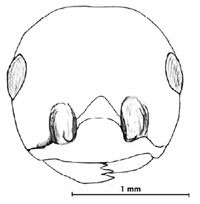Crematogaster montenigrina
| Crematogaster montenigrina | |
|---|---|

| |
| Scientific classification | |
| Kingdom: | Animalia |
| Phylum: | Arthropoda |
| Class: | Insecta |
| Order: | Hymenoptera |
| Family: | Formicidae |
| Subfamily: | Myrmicinae |
| Tribe: | Crematogastrini |
| Genus: | Crematogaster |
| Species: | C. montenigrina |
| Binomial name | |
| Crematogaster montenigrina Karaman, 2008 | |
Little is known about the biology of this species. Karaman reports it is a rare species, having found only three workers over the course of 20 years of studying the myrmecofauna in the area where this species is known to occur.
Identification
Karaman (2008) - Head is, in frontal view, without sculpture, smooth and shining. Thorax finely sculptured, covered with sparse, appressed silvery hairs. Propodeal spines are long, acute, with gently upcurved tips, length of spines is about 2.5 times as long as their basal width. On mesonotum appears distinct longitudinal keel. Whole body, including appendages, dark brown to black. Base of gaster, around the joint edge, is brighter, rest of abdomen is black.
Crematogaster montenigrinus, belongs to Crematogaster scutellaris group of species. Total body length of workers of this species is smallest in compare with other workers of this group in south Europe. Body colour is generally dark brown to black, as in Crematogaster laestrygon and Crematogaster algirica. But C. montenigrinus has distinctly longer propodeal spines (compare with C. laestrygon) and smaller total body length (compare with C. algirica). Workers of Crematogaster montenigrinus has weaker sculptured thorax than those in Crematogaster schmidti. Longitudinal keel less prominent compare with that in C. schmidti and Crematogaster gordani.
Distribution
Latitudinal Distribution Pattern
Latitudinal Range: 42.763146° to 42.763146°.
| North Temperate |
North Subtropical |
Tropical | South Subtropical |
South Temperate |
- Source: AntMaps
Distribution based on Regional Taxon Lists
Palaearctic Region: Montenegro (type locality).
Distribution based on AntMaps
Distribution based on AntWeb specimens
Check data from AntWeb
Countries Occupied
| Number of countries occupied by this species based on AntWiki Regional Taxon Lists. In general, fewer countries occupied indicates a narrower range, while more countries indicates a more widespread species. |

|
Estimated Abundance
| Relative abundance based on number of AntMaps records per species (this species within the purple bar). Fewer records (to the left) indicates a less abundant/encountered species while more records (to the right) indicates more abundant/encountered species. |

|
Biology
Castes
Nomenclature
The following information is derived from Barry Bolton's Online Catalogue of the Ants of the World.
- montenigrina. Crematogaster montenigrinus Karaman, M.G. 2008: 14, figs. 13-16, pl.1 g-i (w.) MONTENEGRO.
- Type-material: holotype worker, 2 paratype workers.
- Type-locality: holotype Montenegro (Crna Gora): Opatovo (Boka Kotorska Bay), 18.viii.1985, 02-08 (M.G. Karaman); paratypes: 1 worker with same data but no. 957P, 1 worker Montenegro (Crna Gora): west mouth of Bojana River (Velika Plaža, Ulcinj), M-254H, 16.vii.2004 (M.K. Karaman).
- Type-depositories: NMPC (holotype); MKPC, NMPC (paratypes).
- Status as species: Karaman, M.G. 2010: 429 (redescription); Karaman, M.G. 2011b: 24; Borowiec, L. 2014: 67; Lebas, et al. 2016: 274.
- Material of the unavailable name atratula referred here by Karaman, M.G. 2008: 14; Karaman, M.G. 2011b: 24.
- Distribution: Montenegro.
Unless otherwise noted the text for the remainder of this section is reported from the publication that includes the original description.
Description
Worker
Holotype: Total length: 3 mm. Head is, in frontal view, without sculpture, smooth and shining, covered with silvery appressed pubescence, these hairs are separated at their bases by a distance equal as length of hairs. Antennal scape is covered with dense, appressed hairs. Mandibles are paler than rest of the head, longitudinally striated, bearing 3-4 teeth each.
Sculpture of thorax weak, covered with sparse, appressed silvery hairs. Propodeal spines are long, acute, with tips gently upcurved, length of spines is about 2.5 times as long as their basal width. On mesonotum appears distinct longitudinal keel. Mesopropodeal furrow deeply impressed. Petiole trapezoid, like that in other species of scutellaris complex.
Abdominal segments entirely covered with longitudinally oriented, appressed, long silvery hairs whose bases are separated by distance equal as half-length of a hair.
Colour: Whole body, including appendages, dark brown to black. Base of gaster, around the joint edge, is brighter, rest of abdomen is black.
Total length, measurement of 3 workers: 2.9-3.1 mm.
Type Material
2 workers, Opatovo (Boka Kotorska Bay), August 18, 1985, leg. M. G. Karaman; 1 worker, West Mouth of Bojana River (Velika Plaža, Ulcinj), July 16, 2004, leg. M. G. Karaman. Holotype (1 worker marked by 02-08) and paratype (1 worker marked by 957P) are deposited in Natural History Museum of Montenegro, Podgorica. Deposition of additional paratype: Karaman's Collection in Podgorica (Crna Gora) (1 worker marked by M-254H)
Etymology
The name of the species is derived from the place where Zimmermann (1934) and we collected samples: Montenegro (Crna Gora).
References
- Karaman, M. G. 2008. Two new species of the Crematogaster scutellaris group, Crematogaster gordani sp. nov. and C. montenigrinus sp. nov. (Insecta: Hymenoptera: Formicidae) from Crna Gora (Montenegro) with the key of this group from southern Europe. Natura Montenegrina 7:5-24.
- Karaman, M. G. 2010. New data of the genus Crematogaster Lund, 1831 (Hymenoptera: Formicidae) in Crna Gora (Montenegro), Part I: Crematogaster scutellaris group of species. Türkiye Entomoloji Dergisi 34:419-434. PF
References based on Global Ant Biodiversity Informatics
- Karaman M. G. 2010. New data of the genus Crematogaster Lund, 1831 (Hymenoptera: Formicidae) in Crna Gora (Montenegro), Part I: Crematogaster scutellaris group of species. Türkiye Entomoloji Dergisi 34 :419-434.
- Karaman M. G. 2011. A catalogue of the ants (Hymenoptera, Formicidae) of Montenegro. Podgorica: Catalogues 3, Volume 2, Montenegrin Academy of Sciences and Arts, 140 pp.

